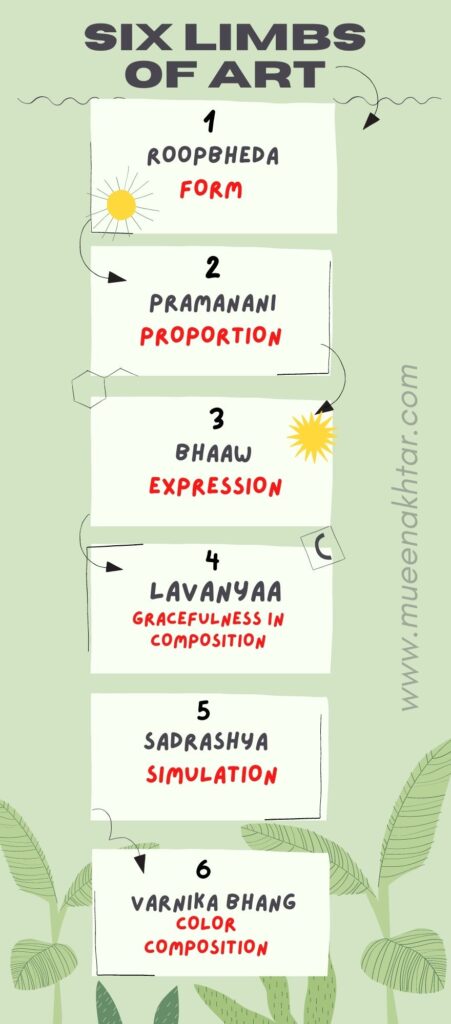Principles (Shadang) Or Six Limbs of Indian Art
The six limbs of Art or the theory of Indian painting is first mentioned in the Kamasutra of Vatsyayana. Six Limbs of Art were composed in B.C. 600-200. Further, Yashodhar Pandit, a resident of Jaipur criticized it in the 11th century and presented the theory of these ancient paintings in one verse:
“Roopbheda: Pramanani, Bhav, Lavanya,
Sadrashya, Varnika Bhang, Iti Chitra Shadangakam.“
According to this stanza, the six limbs or theories of the painting are as follows: –
- Form,
- Proportion,
- Expression,
- Gracefulness in Composition,
- Simulation,
- Color Composition
(Also Read This Article in Hindi – चित्रकला के सिद्धांत )
(Related Post- What is UGC NET )

Form
The form is one of the six limbs of art. It means different types of forms or shapes. It has the secrets and differences of the forms. For example- a form of living and dead, of different angles & Different shapes like round, oval with many colors, hard, soft, rough smooth, etc.
In addition to this, there are 16 types of forms in the Mahabharata’s Shanti-Parva. But these are the external (physical) types of forms.

Infect, there are mysterious distinctions of the form in which an artist should have to be an expert. Therefore, only with torn clothes, one cannot show that this lady is a maid, not a poor’s beloved. Hence, In Vishnu-dharmottara Purana, four types of pictures have been described:
- Truth
- Venic
- Nagar
- Mishra
Now watch this Article in this Video:-
Proportion
In this theory of limbs, Proportion has described body composition according to the appropriate ratio of organs. Indian scholars have mentioned five types of forms. However, they have given their measurement as follows:
- Baal (Boy): Five Taal, like – Gopal
- Kumar: Eight Taal, like Waman
- Human: Ten Taal, such as Arjun, Pandava, Ram, Krishna
- Horrible: Twelve Taal, like – Bhairav, Heyagri, twelve
Baal (Boy): Five Taal, like – Gopal
Kumar: Eight Taal, like Waman
Human: Ten Taal, such as Arjun, Pandava, Ram, Krishna
Horrible: Twelve Taal, like – Bhairav, Heyagri, twelve
Monsters: Sixteen Taal, like Ravana, Kumbkarn
However, the word Taal is used as a unit for measurement. Apart from this, Angul(Finger) proportion is also considered or used. This is a simple fact of Proportion. But the use of these measurements depends on the logic of an artist. The artist should also measure it repeatedly from his Rational Power.
Expression in Six Limbs of Art

The main purpose of composing a painting is an emotional attachment. These two things are basically the same. Any emotional attachments or sudden feeling occurs in the mind after watching a work of art. This is called feeling. An expression is the soul of a picture. Accordingly, it has two following bases:
- Expression of the creator whom he wishes to show in the picture
- The expressions occur in the heart of the viewer by watching the picture.
Thus, we can see the expressions through the eyes in the picture. But some feelings are not concerned only with the vision. Hence, an Artist has to experience to develop for those expressions to show. Consequently, other techniques or remedies have to be used to show the feeling.
(Must Read Article- Progressive Artist Group: Indian Artist Groups)
Gracefulness in Composition (Lavanya Yojnam)
This limb is an important principle of painting. According to this, the image or artwork should be elegant with the expression. As the limb of proportion gives the direction to artwork, this limb of Lavanya Yojnam makes it more excellent. As we discover earlier the expression denotes an inner sense of beauty, while Lavanya Yojnam is a symbol of external beauty. If there is any shortfall after emotion, form, or proportion, sometimes it can be fulfilled by applying it.
Simulation (saradshya)
In this part of the limbs, Simulation is actually to copy (Sadrashya). In Indian painting, Sadrshya is considered as the main Vaastu. That is why this is described in this way:
Chitre saradshya-karanam pradhan parikirtatam.
-Chitra Sutra
In summary, just copying is not enough, and getting the reflection is not enough. Similarly, the meaning of this theory here is the importance of the objects. So the objective related to the subject matter is also important. For example, if you want to visualize the river, it is considered to depict fish, turtles, grasshoppers, lotus, trees, and birds. Accordingly, in Indian art, this quality of simulation for the human body has been discovered in the natural abstracts which are as follows: –
- Eye: Lotus Leaf, Lotus Bud, like Deer, like a Bird or Fish Like
- Ears: Like the wings of a vulture,
- Nose: Like sesame flowers or parrots,
- Nostrils: Like beans,
- Lip: Like the flowering of the beans or beans,
- Soles: Like Neem leaves or bow,
- Fingers of hands: Like beans of beans or Chamba buds,
- Male waist: Like a lion,
- Woman’s waist: Like Damru
- Thighs: Like the elephant trunk
Color Composition in Six Limbs of Art
The last principle-the color composition tells us the perfect and suitable use of color. It tells us the mixing and the use of color with the importance of tools. This principle explains to us where and how to apply color with Tulika (brush). In conclusion, the above five Limbs are useless. Particularly, it does not have a sense of an artist doesn’t know about this theory of color combination.
The painter should have the knowledge of Varnika-Bhang (Color Combination) and should take full care of it. Therefore it is very necessary for a painter to have control over his Tulika (brush).
Conclusion
In this way, an attempt has been made to recite six Siddhantas (Principles) of Indian painting. So, art lovers should take care of them when they make artworks. However, there are no definite rules; neither an artist should follow any certain rules. Even though considering art as a spiritual practice in Indian culture, these principles are presented just like guidance. Ultimately, all artists should continue to carry out efforts and practice regularly to develop their style of art.
Related Useful Books
Related Post
Progressive Artist Group (PAG)
Latest Post
- Role of Art Teacher | Art Teacher in KVS
- गुस्ताव कुर्वे (Gustave Courbet) | Artist of Realism Art
- Honore Daumier | आनॉर दोमिये | Artist of Realism Art
- कला में यथार्थवाद (1800-1899) | Realism in Art
- जराय का मठ बरुआ सागर | Jaray ka Math Barua Sagar
- अब्दुर रहमान चुगताई | Abdur Rahman Chughtai








Hello sir this is very good..
Can I get this blog in Hindi??
..
Now Read this article in Hindi- चित्रकला के सिद्धांत
Hello sir this is very good..
Can I get this blog in Hindi??
can you provide some important question for exam preparation???
Sure why not. You can contact me with your question. Definitely I’ll love to help with them. You can mail me on mueen.akh@gmail.com. I will try to make a new blog in Hindi soon. Right now you can watch it in Hindi in my Video of my Youtube Channel. Link is here- https://youtu.be/Pneo7wjwC18
Mr Mueen, thank you for the very brief but very educative vedio explanation. can you please also tell about 16 roop bheda wrt mahabharat that you mentioned?. Also you spoke about 4types of roopa bheda as per vishnu dharmotara purana, satya, nagar, vaneek and mishra. Can you please elaborate?. Also I would like to know more about the list of sadrushya that you shared. I am doing research on school art education + shadaang. Hence shared the query as above.
Very useful information.
Thank you so much
Pingback: Six Limbs of Art | Write the name of six limps of painting? | Mueen Akhtar
Pingback: बंगाल स्कूल | Bengal school of Art in Hindi | Mueen Akhtar
Pingback: Saturday Night Live Art Show- A great Cause in Pandemic | Mueen Akhtar
I really appreciate that you explained it very well, it’s really helpful matter for my MA exam🙏 do you have any you tube channel
Thanks for your feedback. Yes I have my YouTube Channel. Here is the link- https://www.youtube.com/channel/UCM4Izuxyr8ZnkiplwN35Bxw